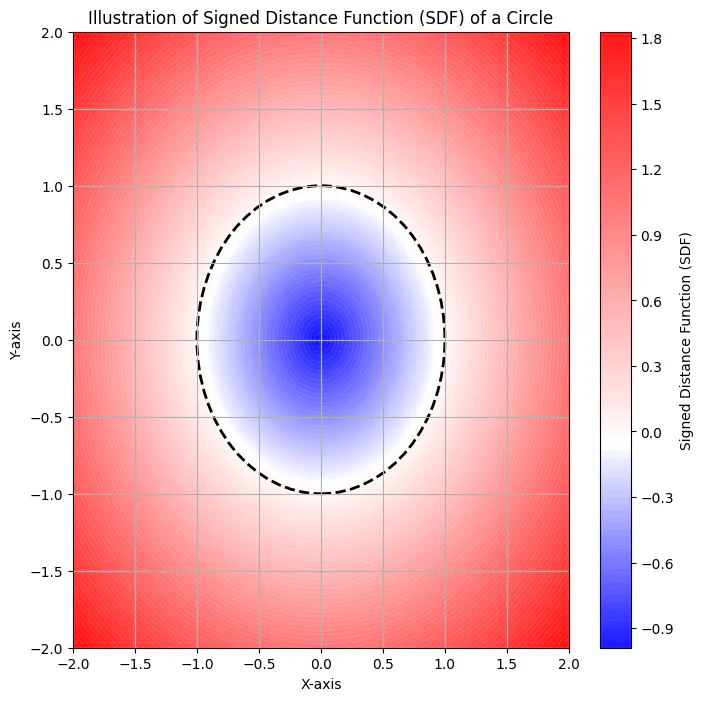 Signed Distance Function (SDF) of a Circle
Signed Distance Function (SDF) of a CircleDemystifying Signed Distance Functions
In the realm of mathematics and computer graphics, signed distance functions (SDFs) play a pivotal role in representing and manipulating geometric shapes. Unlike traditional polygonal meshes, which store vertices and connectivity information, SDFs define shapes implicitly, offering a powerful and flexible approach to 3D modeling and simulation.
What is a Signed Distance Function?
At its core, an SDF is a mathematical function that assigns a real number to each point in space, representing the distance from that point to the nearest boundary of a specified shape. This distance value carries a sign, indicating whether the point lies inside, outside, or on the boundary of the shape.
Properties of Signed Distance Functions
Non-parametric Representation: SDFs describe shapes without explicit geometric data, making them ideal for representing complex shapes and adapting to deformations.
Global Shape Representation: SDFs provide a global representation of a shape, allowing for efficient proximity queries and intersection detection crucial for computational geometry.
Differentiable: SDFs are differentiable, enabling smooth transitions between different shape representations and their derivatives, a key aspect in mesh generation.
Applications of Signed Distance Functions
Mesh Generation for Physics Simulations: SDFs are widely used in physics simulations to represent objects and their interactions, enabling the creation of high-quality meshes representing objects with complex shapes, realistic collision detection and physics calculations.
Level of Detail (LOD): SDFs facilitate efficient LOD management by allowing for the creation of high-quality representations at various levels of detail.
Procedural Modeling: SDFs are the foundation of procedural modeling techniques, enabling the creation of organic and complex shapes from simple mathematical rules.
Graphics Rendering: SDFs play a crucial role in ray tracing algorithms, enabling ray casting and intersection detection for realistic graphics rendering.
Understanding the Mathematical Significance
In mathematical terms, the sign of the distance values generated by the SDF holds crucial information about the relative position of a point to the shape:
Negative Values: Points with negative SDF values lie inside the shape’s boundary. The magnitude of the negative value represents how far inside the point is relative to the nearest surface.
Positive Values: Points with positive SDF values are located outside the shape. Similar to negative values, the magnitude indicates the distance from the point to the nearest surface outside the shape.
Zero Value: A point with an SDF value of zero resides exactly on the shape’s boundary.
Mathematically, the SDF function can be represented as follows for a given point
The sign of
This mathematical understanding is foundational for computational geometry algorithms and plays a pivotal role in mesh generation processes, guiding the placement of vertices and defining the geometry of the resulting mesh.
Mathematical Example: SDF for a Circle
Consider a two-dimensional space (
In this equation:
Now, let’s break down the sign of
- If
- If
- If
This mathematical example illustrates how the SDF values can be computed for a simple geometric shape like a circle, forming the basis for more complex computations in computational geometry and mesh generation.
Example Python Code: Creating a Circle SDF
The following Python code defines an SDF function for a circle:
1import numpy as np
2
3def circle_sdf(x, y, center = [0,0], radius = 80):
4 return np.sqrt((x - center[0])**2 + (y - center[1])**2) - radius
This function takes two-dimensional coordinates as input and returns the distance from the point to the circle’s boundary.
Signed Distance Function Visualization
The visualization of circle SDF is also available at
circle_sdf.pyusing py5 module.